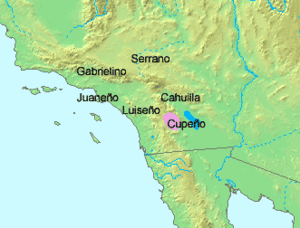Cupeño language facts for kids
Quick facts for kids Cupeño |
||||
|---|---|---|---|---|
| Kupangaxwicham Pe'me̲melki | ||||
| Region | Southern California, United States | |||
| Ethnicity | Cupeño people | |||
| Extinct | 1987, with the death of Roscinda Nolasquez | |||
| Language family |
Uto-Aztecan
|
|||
| Writing system | Latin | |||
 |
||||
|
||||
The Cupeño language was a language once spoken by the Cupeño people in Southern California, United States. Sadly, it is now an extinct language. The last person who spoke Cupeño as their first language was Roscinda Nolasquez, who passed away in 1987. Today, the Cupeño people mostly speak English.
The native name for the language, Kupangaxwicham, means 'people from the sleeping place'. This refers to their original homeland, a place called Ktipa, near Warner's Hot Springs. There was also a smaller village called Wildkalpa nearby.
In the late 1800s, there was a lot of discussion about whether the Cupeño people could stay on their traditional lands. After many years, a court decided that the Cupeño people had to move. They were relocated to the Pala Reservation. The Cupeño language was influenced by older languages and by the Yuman-speaking Ipai people, who lived to their south.
Contents
Where Cupeño Was Spoken
The Cupeño language was originally spoken in areas like Cupa, Wilaqalpa, and Paluqla in San Diego County, California. After the relocation, it was also spoken around the Pala Indian Reservation.
How Cupeño Words Are Built
Cupeño is an agglutinative language. This means that words are formed by adding many small parts, called morphemes, to a base word. Think of it like building with LEGOs, where each small piece adds a new meaning to the word.
In Cupeño, the most important part of a phrase often comes at the end. For example, in sentences, the subject (who or what is doing something) usually comes first, then the object (who or what is being acted upon), and finally the verb (the action). This is called SOV word order. However, sometimes the order can change, especially with verbs or other parts of the sentence.
Nouns and Other Words
In Cupeño, nouns (words for people, places, things), as well as words that describe them like adjectives, change their form. They show things like whether they are singular or plural, and how they are used in a sentence (like if they are the subject or object).
Verbs and Actions
Cupeño verbs (action words) change their form to show many different things. They can show if an action is happening now, happened in the past, or will happen in the future. They also show who is doing the action (like "I," "you," "they").
One interesting feature is called evidentiality. This means the language shows how the speaker knows the information they are sharing. For example, they might add a small word to show if they heard it from someone else, or if they were surprised by it. These small words are called clitics.
- =ku'ut means 'it is said that...' (like reporting something you heard)
- =am means 'mirative' (showing surprise)
- =$he means 'dubitative' (showing doubt)
There are also two main moods for verbs:
- =pe for real actions (things that actually happened or are happening).
- =e'p for unreal actions (things that might happen or are wished for).
Talking About Time
Cupeño verbs show different times and how an action happens.
- Future actions don't have a special ending.
- Past actions use special pronouns.
- Past actions that happened over a period of time (imperfect) add a special modifier.
Here's a simplified look at how verbs change for time and how many people are involved:
| Present | Imperfect | Customary | |
|---|---|---|---|
| Singular | -qa | -qal | -ne |
| Plural | -we | -wen | -wene |
Pronouns
Pronouns are words like "I," "you," "he," "she," "it," "we," and "they." In Cupeño, these words can appear in different forms. Here are some pronouns that attach to verbs when talking about past actions:
| Singular | Plural | |
|---|---|---|
| 1st person | ne- | chem- |
| 2nd person | e- | em- |
| 3rd person | pe- | pem- |
Sounds of Cupeño
The Cupeño language has its own set of sounds, just like English or Spanish. These include different vowel and consonant sounds.
Vowels
Cupeño has several vowel sounds, which can be short or long. Some sounds are similar to English vowels, while others might be a bit different. For example, some sounds mostly appear in words borrowed from Spanish.
Consonants
Cupeño has a variety of consonant sounds. Some are made by stopping the air completely, like 'p' or 't'. Others are made by letting air flow through a narrow space, like 's'. There are also sounds made with the tongue touching different parts of the mouth.
Cupeño Words
Here are a few examples of words in Cupeño:
| English | Cupeño |
|---|---|
| one | suplawut |
| two | wi' |
| three | pa |
| four | wichu |
| five | numaqananax |
| man | naxanis |
| woman | muwikut |
| sun | tamyut |
| moon | munil |
| water | pal |
See also
 In Spanish: Idioma cupeño para niños
In Spanish: Idioma cupeño para niños

